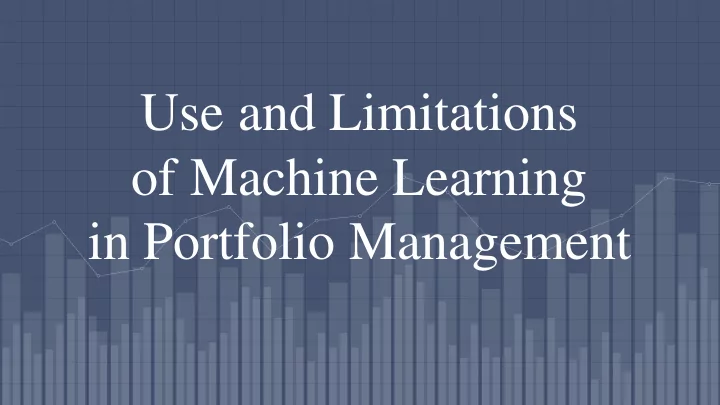

Use and Limitations of Machine Learning in Portfolio Management
Overview 1. Brief Introduction to Learning 2. Prediction - “Futurecasting” - “Nowcasting” - factor analysis 3. Similarity Measures - recommendation system 4. Generating Synthetic Datasets
A Brief Introduction to Learning Learning: Y|X To each problem its solution • Regression: E[Y|X=x] • What we want to know from Y • Dimensionality of the data (X and Y) • Classification: P(Y=y|X=x) • Signal to noise of the data • Synthetic data generation: • Risk function Y|X=x • Stationarity • Etc.
An Introduction to Statistical Learning Great overview of classic machine learning techniques with examples of code in R
Prediction Methods Used • OLS Regression • Lasso, Ridge, Elastic Net • Kernel Regression • Trees • Neural Nets • Random Forests • SVMs • Etc.
Prediction - Things to Consider • Linear versus non-linear • Dimensionality of the data • Density of the data • Signal to noise • Risk function • Interpretability • Over-fitting
Prediction - “Futurecasting” • No access to contemporaneous data • Very difficult to do • Markets tend to be efficient • Signal to noise ratio is poor • It is difficult to beat naïve predictors • Boosted Trees is the leader at the moment
May 2017 Big Data and AI Strategies Good overview of the current use of machine learning in alpha generation and more Big Data and AI Strategies Machine Learning and Alternative Data Approach to Investing Quantitative and Derivatives Strategy Marko Kolanovic, PhD AC marko.kolanovic@jpmorgan.com Rajesh T. Krishnamachari, PhD rajesh.tk@jpmorgan.com See page 278 for analyst certification and important disclosures, including non-US analyst disclosures. Completed 18 May 2017 04:15 PM EDT Disseminated 18 May 2017 04:15 PM EDT This document is being provided for the exclusive use of LOGAN SCOTT at JPMorgan Chase & Co. and clients of J.P. Morgan.
Prediction - “Nowcasting” • Access to contemporaneous data • Important data that is published with a lag or a low frequency • Generating replicating portfolios (Stat Arb) • Live estimates of - ERP - GDP - Macroeconomic indicators - Etc.
Prediction - Factor Analysis • p: number of predictors • n: number of observation • It used to be n>>p - OLS was useful • It is now p>n (zoo of factors) - curse of dimension ▪ dimensionality reduction, PCA, clustering, etc. ▪ best subset, Lasso, Ridge, etc. ▪ K-fold cross validation • Also useful for hedging
Similarity Measures Useful For • Manager selection • Stock selection • Style drift detection
Similarity Measures Methods Used • PCA • Hierarchical Clustering • K-means • Supervised classifiers • Etc. Used For • Alternative data • Big data • Improving analyst’s productivity
Similarity Measures - Things to Consider • Supervised - labeling the target variable and letting the learner infer useful predictors • Unsupervised - choosing predictors where “closeness” is of interest and letting the algorithm do the clustering • Non stationarity of data • Renormalization • Availability of data for back testing
Generating Synthetic Data Useful For • Scenario analysis • Stress testing • Risk budgeting • Option pricing • OOS testing Could be Useful For • Training data for data intensive learners (deep learning, reinforcement learning, etc.) • Testing systematic strategies
Generating Synthetic Data Methods Used • Fitting of parametric models - distributions (poisson, normal, cauchy, etc.) - DGP (EWMA, GARCH, variance gamma process, etc.) • Kernel density estimation • Eigen vector decomposition • Factor analysis • Auto Encoders • LSTM NN
Generating Synthetic Data - Things to Consider • Single versus multivariate inputs • Single versus multivariate outputs • Conditional versus unconditional outputs • Linear versus non-linear relationships • Bulk versus tails of the distribution • Interpretability
Recommend
More recommend